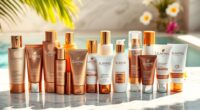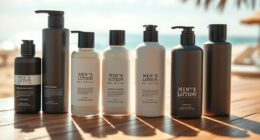Many tanning myths are false. Indoor tanning exposes you to harmful UV rays that increase your risk of skin cancer, accelerate aging, and don’t provide real protection like a “base tan.” Vitamin D is best obtained through safe sun exposure and diet, not tanning beds or supplements. Understanding these facts helps you protect your skin better. Stay tuned to learn more about how tanning truly affects your health and ways to stay safe.
Key Takeaways
- Indoor tanning emits UV rays that are as harmful or more harmful than natural sunlight, increasing skin cancer risk.
- A “base tan” provides no real protection against sunburn or skin damage.
- Tanning beds mainly emit UVA rays, which penetrate deeper and increase skin aging and cancer risks.
- Body stores of vitamin D from fat tissue are insufficient; sunlight and diet are primary sources.
- Occasional tanning adds cumulative damage, and starting young significantly raises melanoma risk.
The Truth About Tanning and Skin Health
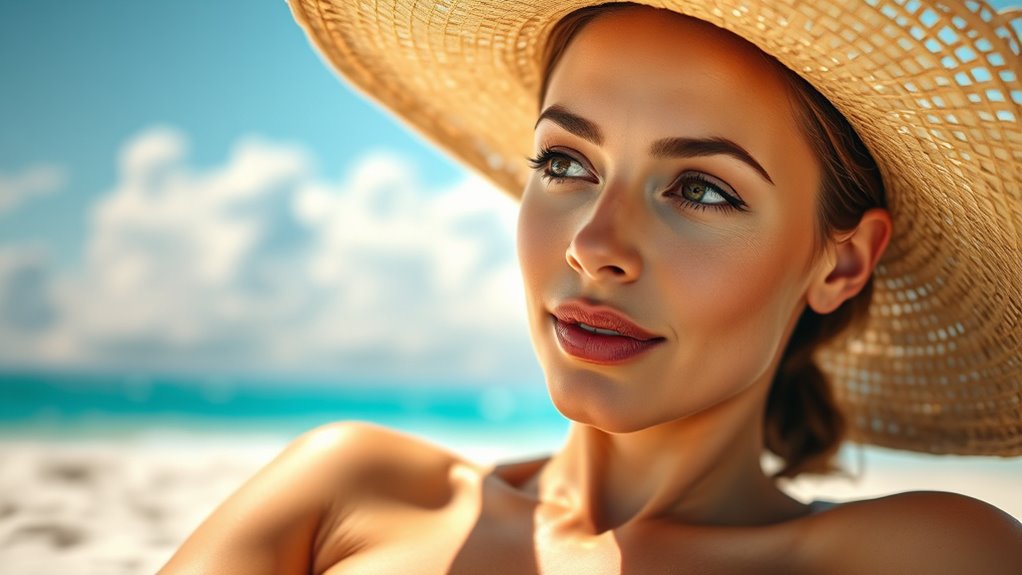
Many people believe that tanning makes them look healthier or more attractive, but the truth is that it poses serious risks to your skin health. Indoor tanning markedly raises your chances of developing skin cancers like squamous cell carcinoma, basal cell carcinoma, and melanoma. Starting to tan before age 35 increases melanoma risk by 75%, and women who tan indoors are six times more likely to develop melanoma in their 20s. Tanning also accelerates skin aging, causing wrinkles, dark spots, and a weathered appearance due to cumulative UV damage. This damage is irreversible and can lead to scars or lesions from skin cancer. Remember, tanning harms all skin types, not just fair skin, and the risks far outweigh any temporary aesthetic benefits. Time management apps can help you organize health information and make informed decisions about skin care. Understanding UV radiation effects highlights how exposure accelerates skin deterioration and increases cancer risk, emphasizing that tanning provides no safe or healthy benefit. Additionally, sun protection strategies are essential for minimizing harmful UV exposure and safeguarding your skin’s health. Recognizing the importance of preventative measures can further reduce your risk of skin damage and promote healthier skin in the long term. Incorporating educational resources about skin health can also empower you to make better choices regarding tanning and sun exposure.
Debunking Indoor Tanning Dangers
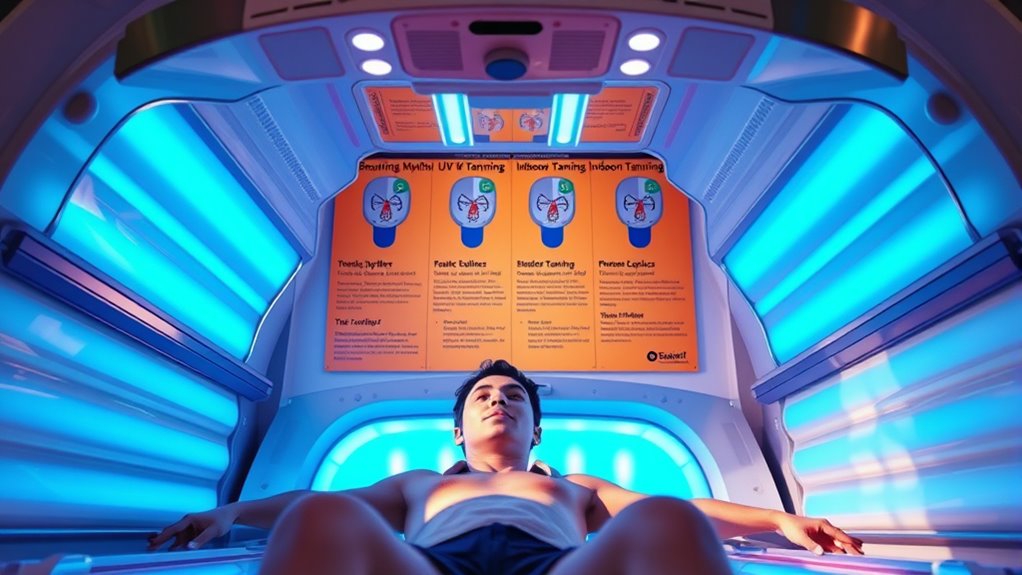
Indoor tanning devices are classified as carcinogens by reputable health organizations, yet misconceptions about their safety persist. Many believe tanning beds are a safer alternative to sun exposure, but they emit UV rays that are just as harmful—sometimes even stronger. This radiation damages your DNA, increasing the risk of skin cancers like melanoma, basal cell, and squamous cell carcinoma. Starting indoor tanning before age 20 raises melanoma risk by nearly 50%, and any use adds up over time. Despite claims of “controlled” exposure, the intensity varies and can cause severe skin damage and premature aging. More people develop skin cancer from indoor tanning than lung cancer from smoking, highlighting just how dangerous it truly is. Avoid tanning beds to protect your skin and your health.
Vitamin D: Myths and Realities

There are numerous misconceptions about vitamin D that can lead to confusion about how much you need and how best to get it. Many believe stored vitamin D in fat tissue can fully supply their needs, but that’s not true. Your body primarily relies on sunlight and diet for vitamin D, not fat stores, which only hold limited amounts. Over-supplementation can cause toxicity, with symptoms like nausea and kidney damage, especially if taken in megadoses. Normal sun exposure usually provides enough vitamin D because your body regulates synthesis, so you don’t need excessive sun or supplements. Age, skin color, and location affect production, and older adults may need more. Vitamin D synthesis is influenced by various factors such as skin pigmentation and geographic latitude. Additionally, individual differences in absorption rates can impact how effectively your body utilizes vitamin D from sources. Maintaining a balanced approach involving testing and consultation with healthcare professionals can help ensure you maintain optimal levels and avoid deficiency or excess. Factors like lifestyle habits and existing health conditions also play a role in your vitamin D status. Always consider individual factors and consult a healthcare professional before supplementing.
How Tanning Affects Your Skin and Protection

Tanning damages your skin cells by causing DNA mutations that can build up over time and increase your risk of skin cancer. When you tan, your skin produces melanin, but this isn’t a sign of protection; it’s a sign of injury. UV rays penetrate deeply, speeding up aging signs like wrinkles, dark spots, and a leathery texture. Sunburn occurs when your skin can’t produce melanin fast enough, leading to inflammation and blood vessel damage. Repeated tanning or burning accumulates DNA damage, profoundly raising your lifetime melanoma risk. Although melanin darkens your skin slightly, it offers minimal protection—SPF 2 to 4—well below what’s recommended. Even darker skin tones aren’t immune; they still sustain UV damage, increasing long-term health risks. AI security advancements include monitoring for vulnerabilities in AI models to prevent misuse and ensure safety. Additionally, understanding the role of attention in creative practice can help develop better protective behaviors like sun awareness and skin monitoring, ultimately reducing damage. Recognizing UV exposure as a significant environmental risk can help motivate individuals to adopt safer sun habits. Proper sunscreen application and protective clothing are also essential components in minimizing long-term skin damage. Exploring photoprotection strategies can further enhance skin safety during outdoor activities.
The Real Risks of Skin Cancer and UV Exposure
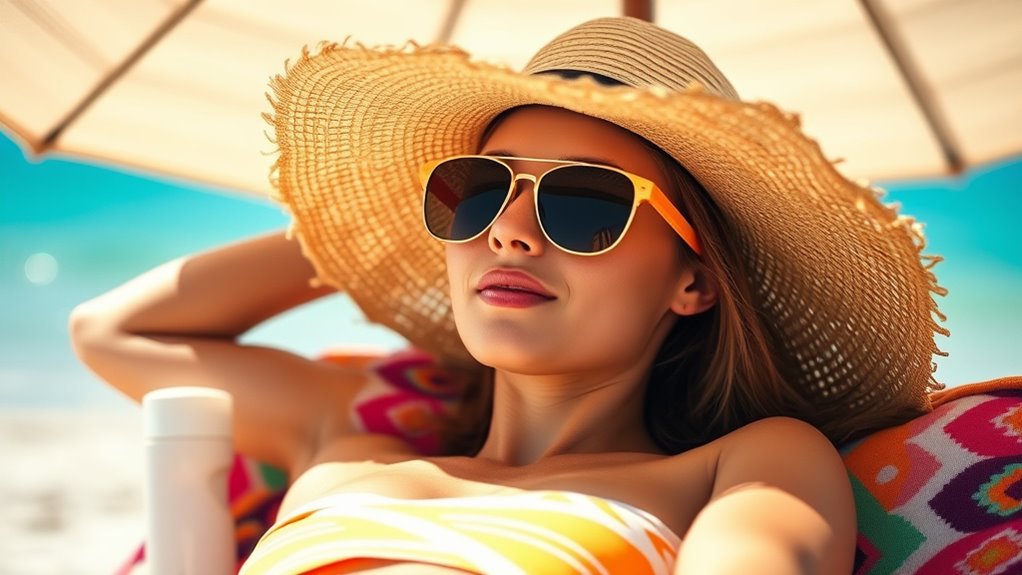
UV exposure poses serious health risks that shouldn’t be underestimated, as it’s a leading cause of skin cancer worldwide. One in five Americans will develop skin cancer by age 70, and more than two people die every hour from it in the U.S. Excessive UV exposure causes about 1.2 million new cases of non-melanoma skin cancers and 325,000 melanomas annually. Early detection can save lives, with melanoma’s five-year survival rate reaching 99% if caught early. UV radiation acts as both a mutagen and damaging agent, increasing risks of basal cell carcinoma, squamous cell carcinoma, and melanoma. Fair skin, genetic factors, and outdoor occupations heighten your vulnerability. Protect yourself using sunscreen, clothing, and shade to reduce these risks and promote long-term skin health.
Common Misconceptions About Tanning Beds
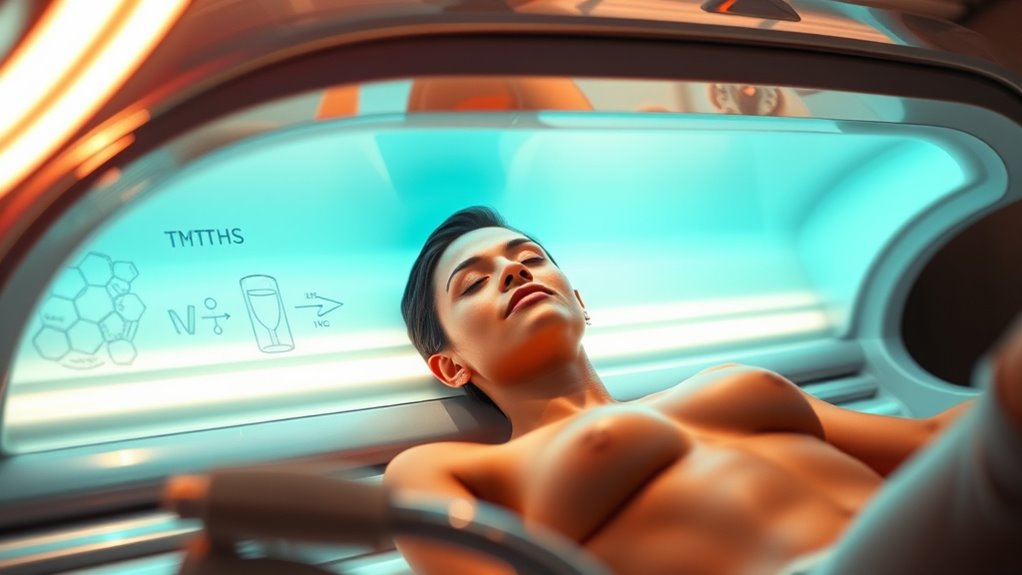
Many people believe that indoor tanning is a safe alternative to natural sunlight, but this is a dangerous misconception. Tanning beds emit mainly UVA rays, which penetrate deeper into your skin than UVB rays from the sun. The UVA intensity from tanning beds is about 12 times higher than natural sunlight, and scientific evidence confirms they’re unsafe. Using tanning beds increases your risk of skin cancers—squamous cell carcinoma by 58% and basal cell carcinoma by 24%. Starting before age 20 raises melanoma risk by 47%, with more frequent use increasing that danger. Many think a base tan prevents sunburn, but it offers no real protection. Tanning damages DNA, accelerates aging, and any exposure, even occasional, adds to long-term health risks. Understanding the risks of UVA exposure is crucial for making informed decisions about tanning. Recognizing the tax implications of health choices can help in planning for potential medical expenses related to skin damage. Additionally, some individuals underestimate how regulatory standards for tanning beds vary by region, which can impact safety and health outcomes. It is also important to note that exposure guidelines are often not strictly enforced, increasing the risk for users. Moreover, ongoing research continuously uncovers new paranormal phenomena that challenge our understanding of reality, highlighting the importance of critical thinking even when dealing with health misinformation.
Protecting Your Skin: What You Need to Know
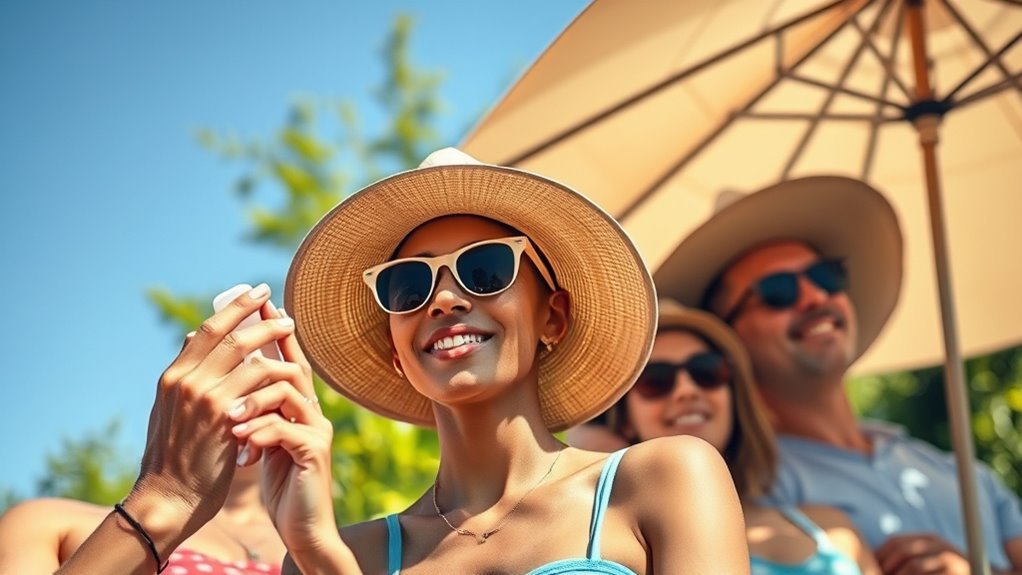
Protecting your skin from the harmful effects of ultraviolet radiation is essential for reducing your risk of skin cancer and premature aging. Over 90% of skin cancer cases come from UV exposure, and one in five Americans will develop skin cancer by age 70. Wearing sunscreen helps delay skin damage, but it’s not foolproof—reapply every few hours and combine with other protections. Cover up with long sleeves, hats, and UV-blocking sunglasses, especially during peak hours (10 a.m. to 4 p.m.). Seek shade and avoid tanning beds to minimize UV exposure. Regular skin checks can catch issues early, improving survival chances. Remember, UV protection is necessary year-round, even on cloudy days, to keep your skin safe and healthy. Ensuring proper wood stove safety standards and installation can prevent fire hazards that endanger your home and loved ones. Additionally, being aware of seasonal variations in UV intensity can help you better plan your sun protection strategies. Incorporating a comprehensive sun safety approach, including awareness of your local UV index, can further enhance your protection efforts. Also, understanding the diverse genres of anime films can provide a more enjoyable and culturally enriching experience, especially when choosing movies for family viewing. A well-rounded approach also involves understanding how crochet styles for locs can influence your overall protective styling choices, promoting both health and aesthetic preferences.
Frequently Asked Questions
Can Tanning Beds Be Used Safely With Proper Precautions?
You might think tanning beds can be safe if you take precautions, but that’s not true. Even with goggles, limited sessions, and following manufacturer guidelines, UV exposure still increases your risk of skin cancer, premature aging, and eye problems. UVA rays penetrate deeply, causing DNA mutations. Safer alternatives like self-tanners or spray tans give you a tan without risking your health. Prioritize your skin’s health over a quick tan.
How Does a Base Tan Actually Affect My Skin’S Protection?
A base tan provides minimal protection for your skin, roughly equivalent to an SPF of 3 or 4. While it might allow you to stay in the sun longer before burning, it doesn’t offer enough protection to prevent skin damage or skin cancer. Relying on a base tan is risky, so it’s much safer to use a broad-spectrum sunscreen with at least SPF 15 to 30, and reapply regularly.
Are There Any Benefits to Indoor Tanning Beyond Vitamin D Production?
Think of indoor tanning as chasing a mirage—you might believe it offers more than meets the eye, but it doesn’t. Beyond vitamin D, there are no proven health benefits. Instead, you risk skin cancer, premature aging, and other skin issues. So, if you’re seeking a mood boost or health perks, consider safer options like exercise, sunlight in moderation, or dietary sources instead of risking your skin on a false promise.
What Are Signs of Skin Damage From UV Exposure?
You should know that UV exposure can cause visible skin damage. Look for signs like wrinkles, broken blood vessels, and uneven pigmentation. You might notice red, irritated skin or dry patches. Over time, your skin could lose elasticity, sag, or develop rough, scaly patches called actinic keratosis. Severe damage may lead to sunburns, blistering, or even early skin aging, increasing your risk for skin cancer.
How Effective Are Sunscreens Compared to Avoiding Tanning Altogether?
You might think sunscreen alone is enough, but avoiding tanning altogether offers even better protection. Sunscreens, like SPF 15 or 50, notably reduce skin cancer risks when used regularly, yet they require consistent application. Avoiding tanning, especially UV exposure from beds or sunbathing, eliminates the primary cause of skin damage. For maximum safety, combine daily sunscreen use with avoiding peak sun hours and tanning altogether, ensuring your skin stays healthier longer.
Conclusion
Now that you know the truth behind tanning myths, you can make smarter choices for your skin’s health. Don’t fall for the hype—indoor tanning isn’t just a bad idea, it’s a ticket to serious skin damage and cancer risks. Protect your skin like a treasure, because your future self will thank you for it. Stay informed, stay safe, and don’t let misconceptions turn your skin into a battleground.

